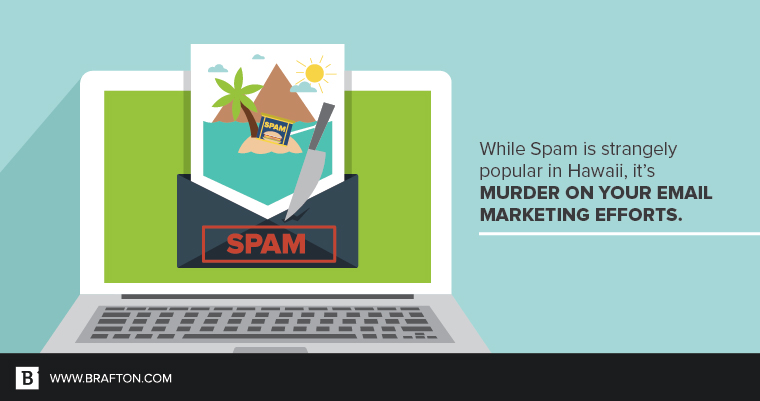Email marketing is here to stay – that’s no surprise. However, simply sending out emails is no guarantee of marketing success.
Recipients have trained themselves to delete anything that appears unfamiliar or unnecessary. Worse yet, they may send your content marketing straight to the spam folder. And while Spam is strangely popular in Hawaii, it’s murder on your email marketing efforts.
If you’re going to break through a wall of distrust and disinterest, you better make sure your email user experience is top notch.
But first, you have to get people to click.

Selecting a subject line
Think of email subject lines like you would a first handshake. The last thing you want is a clammy, awkward hello.
“The subject line determines if you even get an open,” said Jeff Baker, Director of Digital Marketing Strategy at Brafton. “Even the best emails will be ignored a lot of the time anyway, so you have to make sure your subject line is super compelling.”
Tools like CoSchedule’s headline analyzer make it easy to craft subject lines built for engagement. Power words that resonate with readers on an emotional level will win out over boring jargon every time.
“I use that tool to figure out what kind of verbiage will entice someone to click,” Jeff said. “It helps with the writing, but also shows you how it will look in somebody’s inbox. You don’t want your subject line to get cut off. And on mobile devices, people may only see the first couple words, so it’s important to make each one count.”
“If someone opens up your email and is greeted by a mess, they’re going to abort mission.”
Opportunity in an open
Your UX work – or lack thereof – really begins to bear fruit once a recipient clicks open.
“If someone opens up your email and is greeted by a mess, they’re going to abort mission immediately,” Jeff said.
Consider this: While emails are less intrusive than cold calls, they’re in the same ballpark. How would you feel if someone interrupted your dinner with a sales call that was both over the top and poorly executed? If you’re going to demand someone’s attention, the least you can do is put on a persuasive show.
“You have to earn someone’s attention,” Jeff continued. “People probably don’t know you, so it’s arrogant to assume they’re going to read a wall of text that just tells them to buy something. The most valuable thing to a person is time. Why would I give you mine if your email is ugly or confusing or overwhelming?”
Forget generic, text-heavy emails that opt for sales pitches over conversation. Instead, aim for personalized messages that feature eye-catching visuals.
“Your email’s opening lines should put people at ease,” Jeff said. “Personalizing it with someone’s name and title can go a long way toward showing you put time and energy into it. It’s also important to be human. There’s so much sterile, bland content out there – taking a friendly, casual approach will automatically pique someone’s interest.”
Exactly what your email should contain depends on the recipient (you better not be sending boilerplate text to an executive decision maker who’s already shown interest in your brand).
“We’re not going to be talking to executives about organic traffic and social media programs,” Jeff said. “We’re going to be sharing success stories and case studies that focus on hard returns for clients.”
That said, there are some general guidelines to keep in mind:
- Opt for brevity: Time is of the essence. Bulleted lists and short sentences are far better than long paragraphs.
- Incorporate images: Visual marketing is mandatory today, so include custom images, videos or even GIFs to engage readers and break up text.
- Insert CTAs: The next step should always be easy to take. Leverage calls to action (think clickable buttons, not text) to guide recipients on their journey.
Put it to the test
Successful email marketers aren’t born (what a frightening maternity ward that would be), they’re made, and testing is how.
“Using tools like Pardot or Marketo, you can test how emails look on different devices and email service providers before you even hit send,” Jeff said. “From there, your marketing automation tools should be able to report on open rates, click-through rates and other important metrics so you can see what works. You have to collect that data and leverage it, otherwise you’re just shooting your gun in the air without aiming at anything.”
Your email UX shouldn’t waste anyone’s time, and your strategy shouldn’t waste yours. Less than half of marketers test emails for layout and design optimization. Only 26 percent test layout and images for mobile devices.
Show the non-adopters what they’re missing out on next time one of your recipients clicks to convert.





